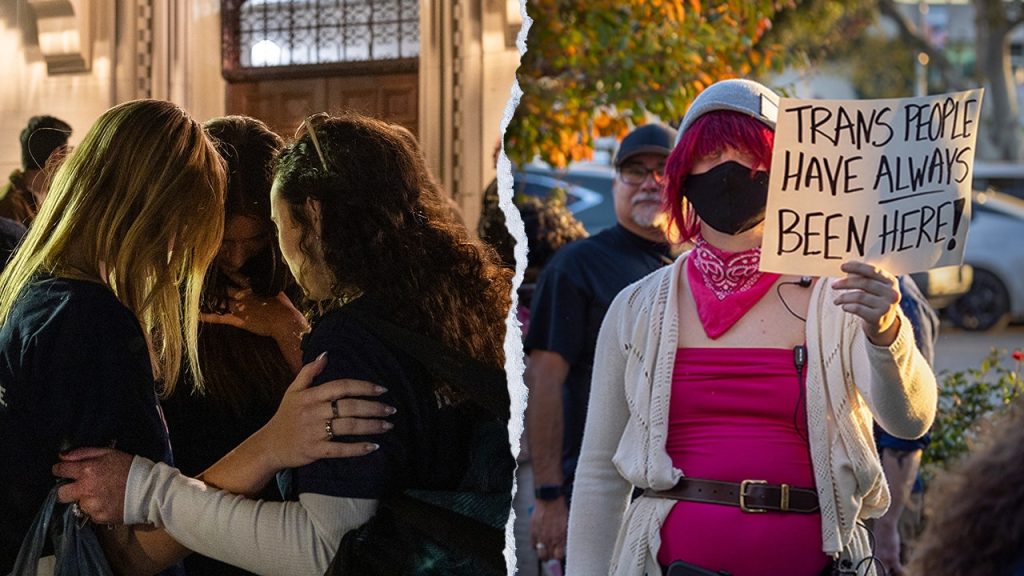The quiet community of Riverside, California, found itself at the epicenter of a national debate regarding transgender athletes in women’s sports, after two high school students, Taylor Starling and Kaitlyn Slavin, took a stand against a transgender athlete competing on their girls’ cross country team. Starling, a seasoned runner, lost her varsity spot to the transgender athlete, a new transfer student, while Slavin, a freshman, expressed shock and concern about competing against biological males in her first year of high school. Their experience highlighted the complex issues surrounding fairness, inclusion, and the rights of female athletes in the context of evolving gender identities.
The controversy escalated when Starling and Slavin wore “Save Girls Sports” shirts to school in protest. Their simple act of dissent sparked a chain reaction, becoming a rallying cry for hundreds of students and community members who adopted the shirts as a symbol of their support. The girls’ protest, however, was met with resistance from school administrators who allegedly compared the shirts to swastikas, a comparison that underscored the highly charged nature of the debate and the differing interpretations of free speech and symbolic protest. This clash led to a lawsuit against the Riverside Unified School District (RUSD), further intensifying the media spotlight on the small town.
The unfolding events subjected Starling and Slavin to an unprecedented level of public scrutiny. While they received messages of support and gratitude from people across the nation who shared their concerns about protecting women’s sports, they also faced backlash. Fellow students wearing the “Save Girls Sports” shirts were allegedly harassed, cursed at, and subjected to online abuse, demonstrating the polarizing nature of the issue and the sometimes hostile reactions it elicits. For Slavin, who had always found solace and stress relief in sports, the situation created additional anxiety and pressure, highlighting the emotional toll of the controversy on the young athletes.
Beyond the competition itself, the presence of a transgender athlete also raised concerns regarding locker room access and school policies. Starling reported the transgender athlete using the girls’ restroom and, while locker room interactions were limited due to the athlete’s alleged frequent absence from practice, the issue of shared spaces remained a source of unease for some students and parents. Further fueling the controversy were allegations that the transgender athlete was allowed to compete on the varsity team despite consistently missing practice, a claim that was disputed by the RUSD. These allegations, coupled with the school administration’s alleged statement that “transgenders have more rights than cisgenders,” further inflamed tensions between the families involved and the school district.
The RUSD maintained that its actions were in compliance with California state law, which prohibits discrimination based on gender identity and gender expression in athletics. The district also pointed to national and state-level policies as the driving force behind their decisions, suggesting that local protests should be directed towards those with the power to change such laws. This response, however, did little to quell the growing discontent among parents and students who felt their concerns were being ignored. The controversy reached a boiling point during a heated school board meeting where impassioned speeches, both for and against transgender inclusion in sports, were delivered. The meeting, characterized by shouting, emotional outbursts, and displays of LGBTQ pride flags, illustrated the deep divisions within the community. Reports of harassment and verbal attacks outside the meeting further highlighted the tensions surrounding the issue.
Despite the ongoing legal battle and the contentious school board meeting, the student-led protest continued to gain momentum. Hundreds of students, undeterred by disciplinary actions such as detention, continued to wear the “Save Girls Sports” shirts every Wednesday, turning their act of defiance into a weekly ritual. The movement spread to other schools within the district, demonstrating the growing support for Starling and Slavin’s cause. The girls, along with their attorney, reaffirmed their commitment to their cause despite facing continued opposition from school administrators. In the face of uncertainty about the future of girls’ sports, they called upon their supporters for prayers and continued advocacy. Their story became a microcosm of the larger national debate, highlighting the complex and multifaceted challenges of navigating issues of gender identity, inclusion, and fairness in the context of competitive sports.

